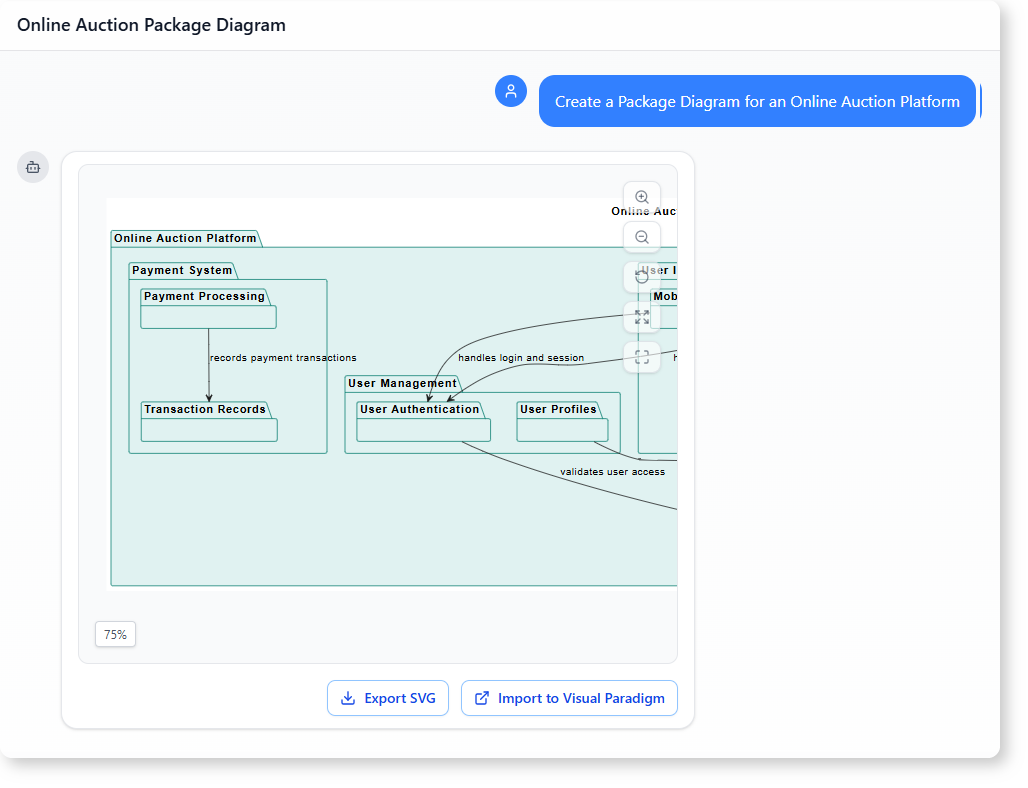Now Reading: How to Generate a Package Diagram for an Online Auction Platform with AI
-
01
How to Generate a Package Diagram for an Online Auction Platform with AI
How to Generate a Package Diagram for an Online Auction Platform with AI
How to Generate a Package Diagram for an Online Auction Platform with AI
Imagine you’re building an online auction platform. The system grows quickly—adding features like item management, user authentication, and bid tracking. Without a clear structure, it’s easy to lose focus.
You don’t need to write code or manually draw every component. Instead, you can describe the system’s structure, and an AI-powered modeling tool generates a clean, accurate package diagram with clear explanations.
This guide walks through a real user interaction that shows how AI helps create a package diagram for an online auction platform. It explains the journey from idea to visual output and what the result truly means.

The User’s Background and Goal
The user is a software developer working on a new e-commerce feature—an online auction platform. They’ve defined the main components but lack a clear architectural breakdown. Their goal is to understand how different parts of the system relate to each other.
They don’t want to spend hours organizing the system into packages. Instead, they want to describe the system in simple terms and get a structured visual output that explains the roles of each package.
The Journey: From Prompt to Package Diagram
The user starts by asking the AI tool to generate a package diagram for an online auction platform. The prompt is simple and clear:
Create a Package Diagram for an Online Auction Platform
The AI interprets this request and builds a hierarchical structure showing the major parts of the system. It organizes the components into logical packages, such as Auction Management, User Management, and Database layers.
After the diagram is generated, the user asks a follow-up question:
Explain the role of each package in the system’s architecture.
Instead of just showing the structure, the AI now provides a clear explanation of each package’s purpose—what it does, how it connects to others, and why it exists.
This isn’t just a diagram. It’s a conversation that builds understanding.
What the AI Delivers
The resulting package diagram breaks down the platform into manageable parts:
- Auction Management: Handles the lifecycle of items and bids.
- User Management: Manages user accounts, profiles, and authentication.
- Database Layer: Stores and retrieves data for items, bids, and users.
- User Interface: Covers both web and mobile experiences, including notifications.
- Payment System: Processes transactions and maintains records.
Each package is clearly labeled and connected with meaningful relationships. For example:
- The Item Management package retrieves details from the Item Database.
- The Bid Management module stores and accesses bid data.
- The Web and Mobile Interfaces use authentication to secure access.
The AI also identifies shared elements—such as a Common Interface—which both web and mobile interfaces inherit. This reveals a design pattern that improves consistency and reduces code duplication.
Why This Matters for Developers
This kind of AI modeling tool helps developers think about system structure before writing any code. It turns abstract ideas into visual patterns that can be discussed in meetings or shared with stakeholders.
It’s not a magic tool that replaces design thinking. But it does make the early stages of modeling faster, clearer, and more collaborative.
The package diagram isn’t just a static image. It serves as a reference point for conversations about scalability, security, and future features.
Real-World Use Case: The Chat Session
You can explore the full conversation and see how the AI interprets the user’s request step by step. The session shows exactly how the tool listens, interprets, and responds to natural language.
For developers, product managers, or anyone building a system, this workflow shows how AI-powered modeling software can support real-world design decisions.
Is This the Future of System Modeling?
Not all modeling tools are equal. Some require deep technical knowledge to create diagrams. Others focus on one type of diagram and lack context.
An AI-powered modeling software, like the one used here, understands natural language and turns high-level descriptions into structured visual models. It doesn’t just draw boxes—it explains them.
This makes it accessible to non-experts and reduces the barrier to entry for system design.
Frequently Asked Questions
Q1: Can I use this AI to generate a package diagram for any system?
Yes. The tool works with any domain—e-commerce, auction systems, logistics, or financial platforms. As long as the user describes the system clearly, the AI can generate a relevant package diagram.
Q2: Does the AI explain the relationships between packages?
Yes. After generating the diagram, the AI can explain dependencies, such as which package accesses which database or handles user login.
Q3: How does the AI understand system structure?
It uses natural language patterns to identify key components and group them into logical packages. It then builds a hierarchy that reflects real-world usage and data flow.
Q4: Is this tool suitable for use in agile development?
Absolutely. The ability to generate a package diagram quickly allows teams to align on architecture early, which supports faster iteration and better communication.
Ready to map out your system’s interactions? Give our AI-powered modeling software a try at Visual Paradigm’s AI Chatbot today!.
